SD Card Blank or Unsupported File System? Here Are the Solutions!
If you insert your SD card on your Android device or computer and you suddenly see an SD Card Blank or Unsupported File System error. Then Don’t fret. This article will show the most complete solutions to fix this error and how to recover data if you formatted SD cards.
Common Android Issues
Android Screen Issues
Android Connect Issues
Android App Issues
Samsung Galaxy Android phone failed to display the micro SD card. Instead, it flashed the message “Blank SD card” and asked to format it. But nothing happens when I try to format the micro SD card. I’m unable to access any of the files on my SD card. Please assist me in resolving this problem.
Well, SD cards have been increasingly popular in recent years, with users using them to transfer working papers, save photographs in cameras, expand Android’s internal storage, and make boot media, and many other things. However, we may run into a number of SD card troubles while using it, such as the SD card being unexpectedly removed, images saved on the SD card disappearing, and the SD card refusing to mount.
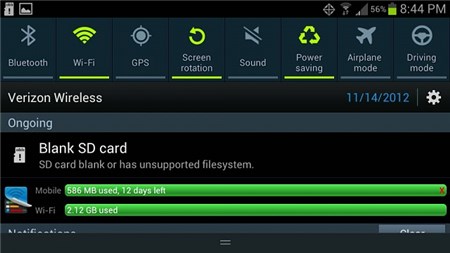
SD Card Blank or Unsupported File System
And the one we’re discussing today is most likely the one you’re looking for. “Blank SD card” means that the SD card is either blank or has an unsupported file system.
In this article, we shall define why SD cards suddenly become blank. And efficient methods to fix this error. Also, Continue reading to learn how to recover data from formatted SD cards, involving photographs, videos, and other files on Android.
Why Is My SD Card Suddenly Blank?
Why is the SD card in Android phones blank or has an unsupported system? In general, a mobile phone memory card can become blank or have an unsupported file system for a variety of reasons, including virus infection, rude extraction, logical damage, RAW file system, and others.
And if you are suffering from this issue, you should consider the following:
- Have you removed the SD card last time without turning off your cell phone?
- Did you use this SD card on an unusual or risky computer?
- Were you using this SD card on any other OS (say BlackBerry and back to Samsung)?
- Has your PC or laptop taken out this SD card without utilizing the hardware removal tool?
If that’s the case, it’s possible that you’re getting the blank SD card error.
To avoid such memory card errors in the future, please use it properly on your phone, computer, or other devices, and be careful to remove your phone SD card safely. Of course, significant SD card data backups should be made on a regular basis in case of unexpected data loss difficulties.
How to Fix a Blank SD Card?
In this section, we’ll look at five solutions to this SD card blank problem. But before that, please ensure that the SD card itself is in good shape and can be recognized by your computer. Only in this manner is it possible and necessary to repair this micro SD card.
Method 1. Reboot the Android Phone
Although the operating system demands you to format the blank SD card, DO NOT DO SO IMMEDIATELY; instead, consider other solutions. First and foremost, rebooting your Android phone should always be the first attempt. To reboot your device follow these steps.
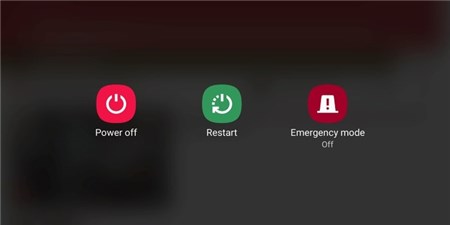
Select the Restart Option
- Switch off your Android device (steps may vary depending on the device to device).
- Turn on the Android device to check if the SD card error is fixed or not.
Turn on the Android device to check if the SD card error is fixed or not.
Method 2. Re-insert the SD Card
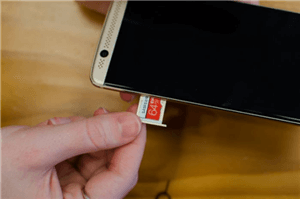
Re-insert the SD Card and Restart Your Phone
The next method to fix the error is to Re-insert the SD card and check. To do so: You should take out your SD card from an Android device and re-insert and check.
Method 3. Check “Specialty Files” in Your SD Card
If the file system were correct, it would look blank when the data was configured to be hidden on your SD card, microSD. And now it’s time to reveal the secret files because an SD card may contain “specialty files” that must be erased. Connect it to your computer via a card reader, then proceed with the steps below.
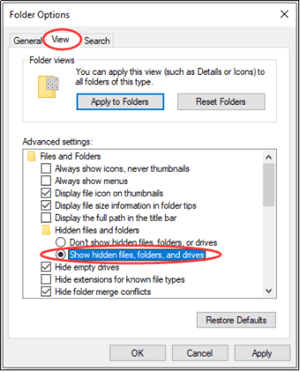
Check Specialty Files in Your SD Card
- Connect a blank SD card to your computer using a card reader and ensure the PC detects it.
- Go to the Search tab and type Run, and open the File Explorer Option.
- Turn on the View tab and look for check Show hidden files, folders, and drives and save the changes.
- Delete the Specialty Files if you find any.
Method 4. Format the SD card
The next method is mainly concerned with formatting an SD card to resolve the sd card blank problem. We strongly advise you to backup your SD card before proceeding with the instructions to avoid data loss. Here, we will discuss different ways on how to format SD cards using various systems.
Way 1. How to Format an SD Card on a PC Computer
If you’re using a Windows or laptop computer, you’ll format your SD card using File Explorer. Before you begin, make a backup of all the data you intend to save. Also, if you’re using a laptop, be sure it’s plugged in or has enough battery power to last a long time.
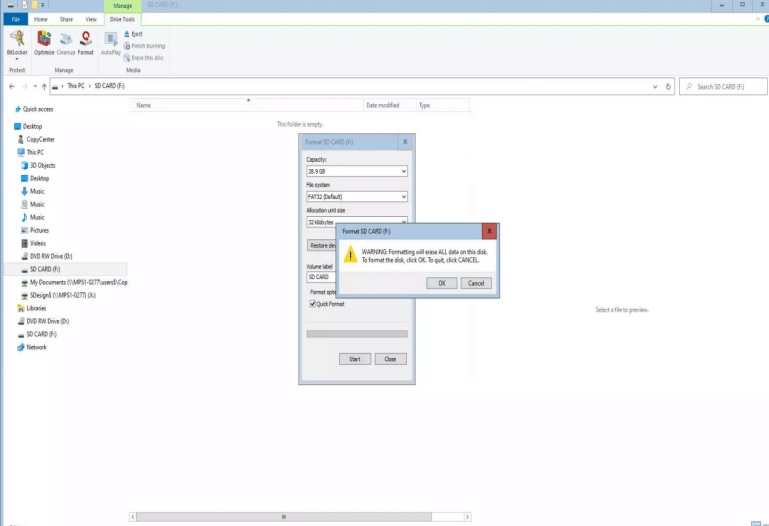
Format an SD Card on a PC Computer
- Insert the SD card into your PC or an external USB reader.
- Open the File Explorer, next in the column on the left side, tap on This PC or My Computer.
- Now tap on the SD card, and at the top, you can see Format; once you click on that, a pop-up appears.
- In the pop-up window, tap NTFS if you want to use the card on a Windows computer or FAT32 for multiple devices.
- If this is your first time formatting an SD card, leave the checkbox next to Quick Format unchecked. If you’ve previously formatted this SD card, the Quick Format checkbox can be left ticked.
- Finally, click on Start to complete the formatting.
Once the process is complete, you can eject the SD card and remove it from the SD card reader.
Way 2. How to Format an SD Card on a Mac Computer
To format your SD card on a Mac, use the Finder. Make sure you’ve backed up and saved any data you want to save from the card, then plug in your laptop if you’re using one.
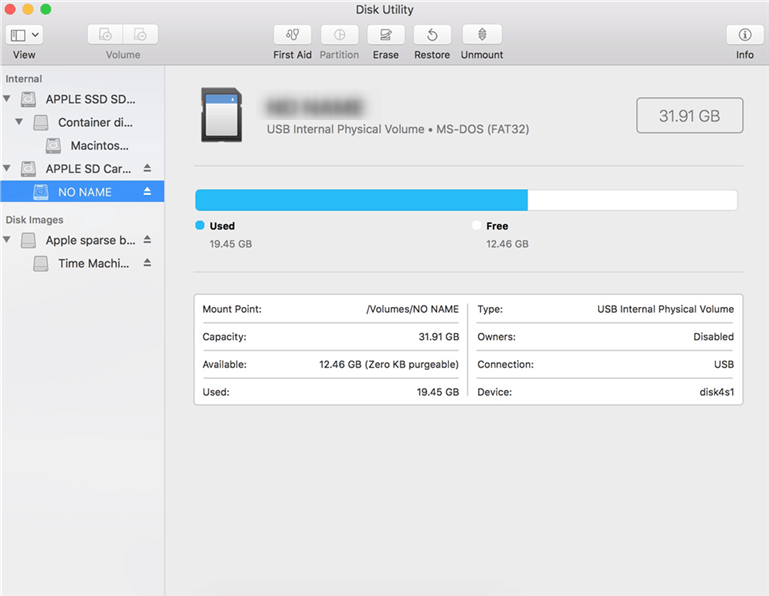
Format an SD Card on a Mac Computer
- Insert your SD into your Mac’s SD card slot or attach a USB card reader to the Mac.
- Open Finder, and then tap on the Go button and hit on Utilities.
- In the utility window, double-tap on Disk Utility, a new window appears.
- Click on the SD card that is underneath the External header.
- Click the Erase button in the upper-right corner of the window.
- Tap on Format to open a drop-down menu. Select ExFAT if your SD card is 64 GB or larger and if it’s 32 GB or smaller select MS-DOS (FAT).
- Finally, tap on Erase to format the SD card using Mac.
Way 3. How to Format an SD Card on an Android Device
If you have an Android device, you can format the SD card with your phone. However, before you begin, please ensure that your phone is set up with this feature. As an example, here we consider the Samsung phone.
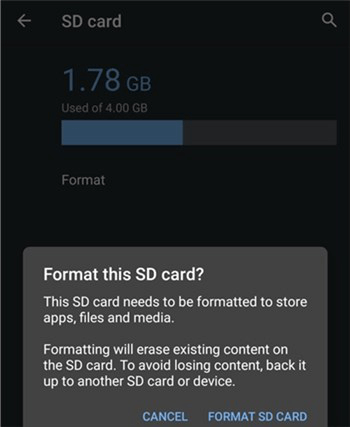
Format an SD Card on an Android Device
- Navigate to Settings on your Android device, and search for Device Care.
- Tap on Storage and hit the Advanced option.
- Under the Portable storage, select the SD Card and hit on Format.
Method 5. Try a New SD Card
When you format the card, you may get the message “SD card blank or Unsupported File System.” In this scenario, replacing the SD card is worth a shot. You can test this technique using one of your little storage cards to check if the phone detects or reads it.
If NOT, try different cards, and if the results remain the same, it’s the phone’s fault, most likely the firmware. Why? Because the phone detects the presence of a card but is unable to read it, the problem is not one of hardware but one of the firmware. Check to see if an update is available; if so, install it.
Bonus Tip. How to Recover Data from a Formatted SD Card?
DroidKit is an all-in-one Android phone solution that allows you to recover data from a formatted SD card or recover lost information from an SD card on Android. The specially designed function – Deleted Formatted SD Card Recovery will assist you in unformatting sd cards and retrieving data from them if you accidentally formatted a Micro SD card or deleted files by mistake. What can you do with DroidKit’s SD card data recovery tool? Check them out right now.
Free Download * 100% Clean & Safe
- You can recover files from an SD card that have been deleted or formatted.
- You can access images, movies, audio, books, and other things on your SD card.
- You don’t need to root your device, and DroidKit can scan and recover data from your SD card in minutes.
- The SD card in your camera, in addition to the SD card in your Android phone, is supported.
- Furthermore, DroidKit allows you to retrieve deleted files, including WhatsApp, directly from your device.
The following are the steps to recover files from a formatted SD card on an Android device:
Step 1. Install the most recent version of DroidKit on your computer; once done, Run the tool and select Data Recovery from SD Card.
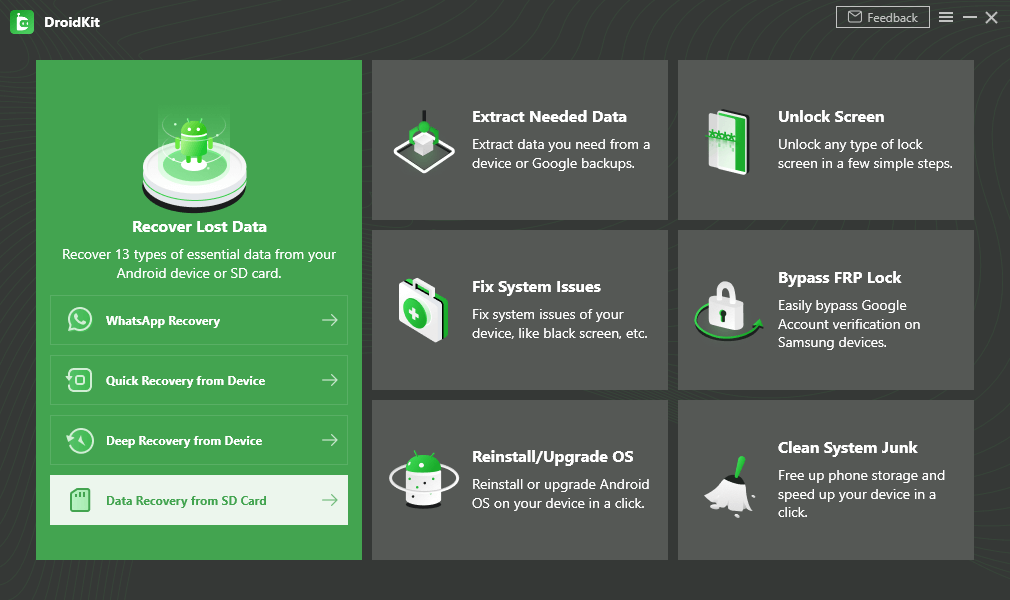
Choose Data Recovery from SD Card
Step 2. Now, click on Standard Recovery or Advanced Recovery based on your needs.
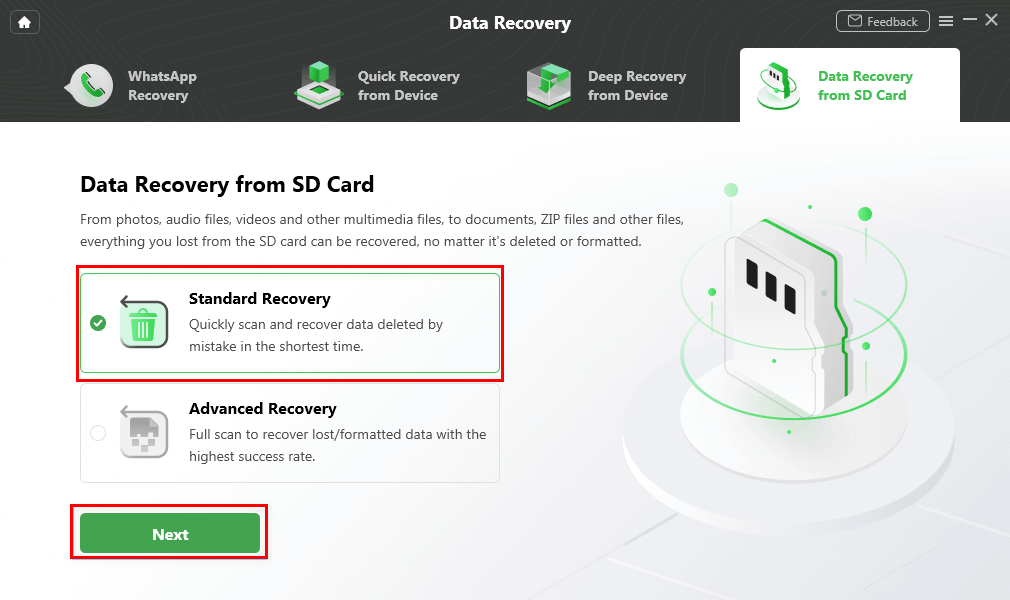
Choose One Recovery Mode
Step 3. After this, tap on the Next button to scan data on your SD card.
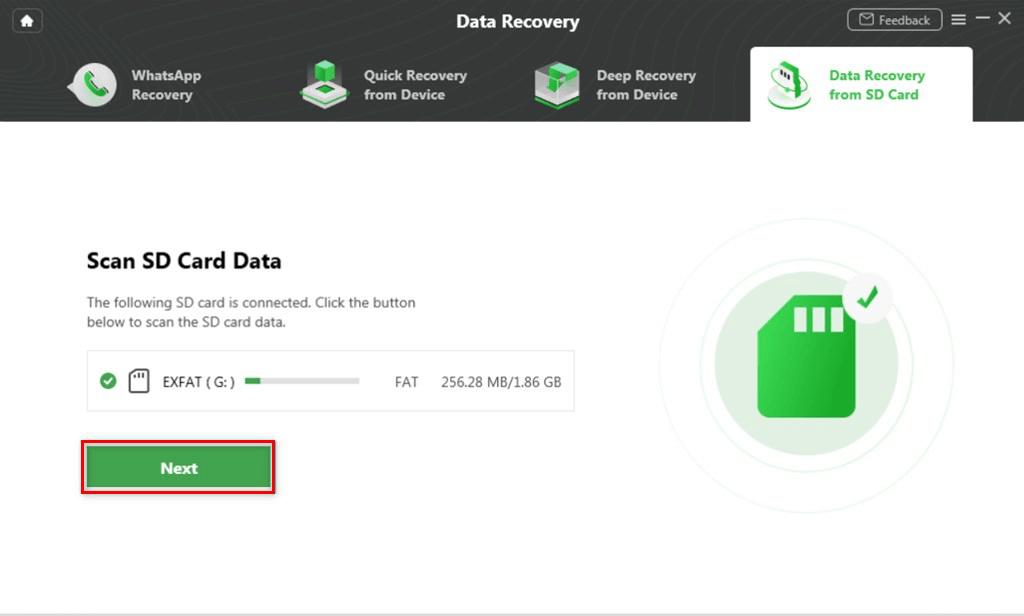
Scan SD Card Data
Step 4. Once the scan process is completed, you can preview all the files on your SD card. After that, select the File Type you want; once selected, click to PC and transfer files.
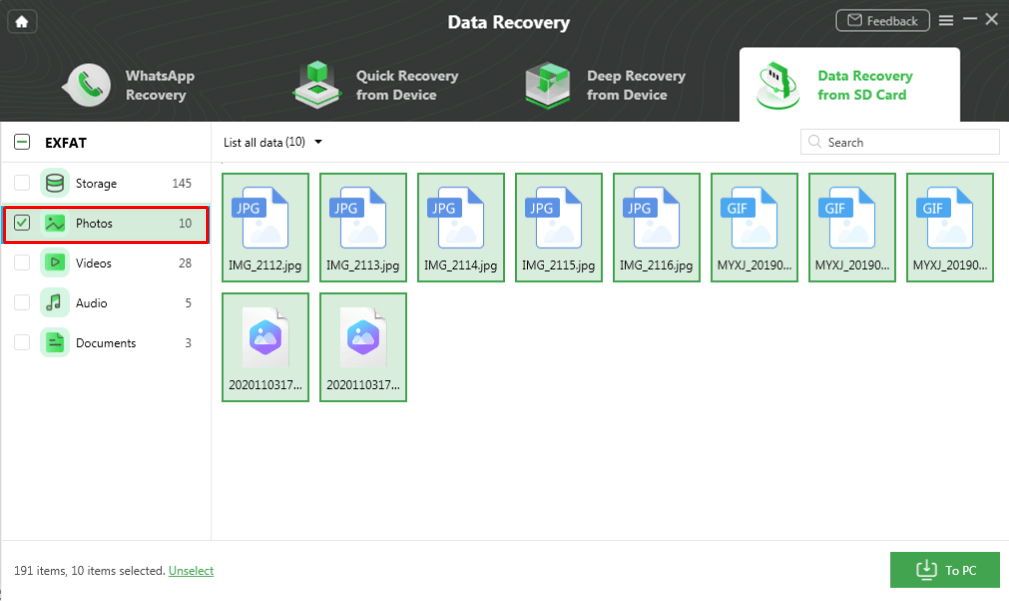
Select Data and Click To PC
The Bottom Line
In a nutshell, the Android blank SD card issue has been a significant source of concern for many years, and similar issues can be found all over the internet. In this article, we discussed the probable causes of this problem as well as 5 solutions. We hope these solutions make it easier for you to fix SD card blank errors. If you need to restore deleted data after formatting an SD card, we highly recommend giving DroidKit a shot. If you have any further suggestions for retrieving formatted files from SD cards or any concerns about this article, please drop your comments below.
More Related Articles
Product-related questions? Contact Our Support Team to Get Quick Solution >

